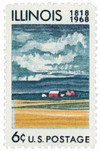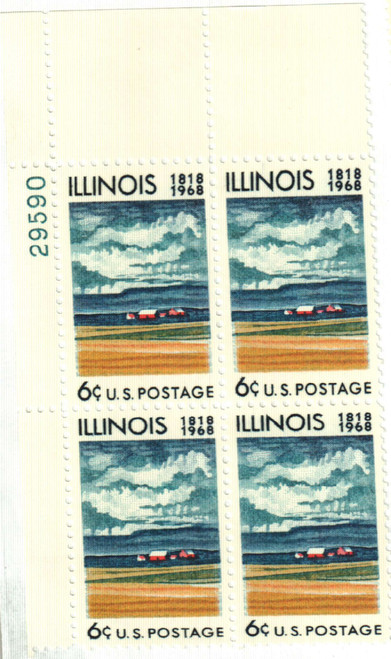
# 1339a - 1968 6c IL Statehood, tagging omitted
U.S. #1339a Tagging Omitted
6¢ Illinois Statehood
Issue Date: February 12, 1968
City: Shawneetown, IL
Printed By: Bureau of Engraving and Printing
Printing Method: Lithographed, engraved
Perforations: 11
Color: Dark blue, blue, red and ocher
This stamp was issued for the 150th anniversary of Illinois’ statehood.
Illinois’ Road to Statehood
Fewer than 2,000 whites lived in Illinois when the American Revolution began in Massachusetts. These people were missionaries, fur traders, farmers, and British soldiers. George Rogers Clark of Virginia led a force of frontiersmen, known as the “Big Knives,” against the British in Illinois. Rogers was able to capture Kaskaskia and Cahokia in 1778. Illinois was then made a county of Virginia.
As the representatives of the states prepared to sign the Articles of Confederation, Maryland refused to ratify the document unless Virginia and other states that held western lands gave up their claims. So, in 1784, Virginia gave Illinois to the federal government. When Congress passed the Northwest Ordinance of 1787, Illinois was made part of the Northwest Territory. In 1800, it became part of the Indiana Territory. Then in 1809, present-day Illinois and Wisconsin were grouped together as the Illinois Territory.
On December 3, 1818, Illinois achieved statehood. However, at that time, only the southern third of the state was settled. Nathaniel Pope, the territorial governor, had the northern border pushed to its current boundary. This gave the state access to the Chicago port area, lead deposits around Galena, and the rich dairy areas of the north. Today, more than two thirds of the state’s population lives in this northern territory. In 1837, the capital was changed to Springfield – Abraham Lincoln was the key proponent of this change.
Now you can own this stamp with rare tagging omitted. Did you know a stamp missing its phosphorescent tagging is considered by many to be similar to a missing color error? The good news is that unlike some error stamps, untagged error stamps are affordable.
What is Phosphorescent Tagging and Why is it Important?
Tagging of U.S. stamps was introduced in 1963 with airmail stamp #C64a. It helps the U.S. Post Office use automation to move the mail at a lower cost. A virtually invisible phosphorescent material is applied either to stamp ink or paper, or to stamps after printing. This “taggant” causes each one to glow in shades of green (red on older airmails) for a moment after exposure to short-wave ultraviolet (UV) light. The afterglow makes it possible for facing-canceling machines to locate the stamp on the mail piece, and properly position it for automated cancellation and sorting.
Some stamps have been printed with and without tagging intentionally, but when tagging is omitted by accident, we collectors are treated to a scarce modern color error. Our stamp experts examined thousands of stamps to find these just for you. Now you can easily give your error collection a boost or explore this fascinating new area of collecting. Quantities are limited, so order your untagged error stamp right away.
And find more tagging omitted stamps here.
U.S. #1339a Tagging Omitted
6¢ Illinois Statehood
Issue Date: February 12, 1968
City: Shawneetown, IL
Printed By: Bureau of Engraving and Printing
Printing Method: Lithographed, engraved
Perforations: 11
Color: Dark blue, blue, red and ocher
This stamp was issued for the 150th anniversary of Illinois’ statehood.
Illinois’ Road to Statehood
Fewer than 2,000 whites lived in Illinois when the American Revolution began in Massachusetts. These people were missionaries, fur traders, farmers, and British soldiers. George Rogers Clark of Virginia led a force of frontiersmen, known as the “Big Knives,” against the British in Illinois. Rogers was able to capture Kaskaskia and Cahokia in 1778. Illinois was then made a county of Virginia.
As the representatives of the states prepared to sign the Articles of Confederation, Maryland refused to ratify the document unless Virginia and other states that held western lands gave up their claims. So, in 1784, Virginia gave Illinois to the federal government. When Congress passed the Northwest Ordinance of 1787, Illinois was made part of the Northwest Territory. In 1800, it became part of the Indiana Territory. Then in 1809, present-day Illinois and Wisconsin were grouped together as the Illinois Territory.
On December 3, 1818, Illinois achieved statehood. However, at that time, only the southern third of the state was settled. Nathaniel Pope, the territorial governor, had the northern border pushed to its current boundary. This gave the state access to the Chicago port area, lead deposits around Galena, and the rich dairy areas of the north. Today, more than two thirds of the state’s population lives in this northern territory. In 1837, the capital was changed to Springfield – Abraham Lincoln was the key proponent of this change.
Now you can own this stamp with rare tagging omitted. Did you know a stamp missing its phosphorescent tagging is considered by many to be similar to a missing color error? The good news is that unlike some error stamps, untagged error stamps are affordable.
What is Phosphorescent Tagging and Why is it Important?
Tagging of U.S. stamps was introduced in 1963 with airmail stamp #C64a. It helps the U.S. Post Office use automation to move the mail at a lower cost. A virtually invisible phosphorescent material is applied either to stamp ink or paper, or to stamps after printing. This “taggant” causes each one to glow in shades of green (red on older airmails) for a moment after exposure to short-wave ultraviolet (UV) light. The afterglow makes it possible for facing-canceling machines to locate the stamp on the mail piece, and properly position it for automated cancellation and sorting.
Some stamps have been printed with and without tagging intentionally, but when tagging is omitted by accident, we collectors are treated to a scarce modern color error. Our stamp experts examined thousands of stamps to find these just for you. Now you can easily give your error collection a boost or explore this fascinating new area of collecting. Quantities are limited, so order your untagged error stamp right away.
And find more tagging omitted stamps here.







